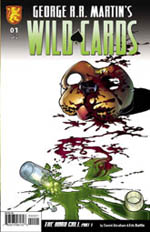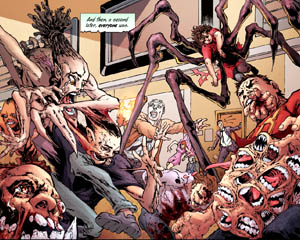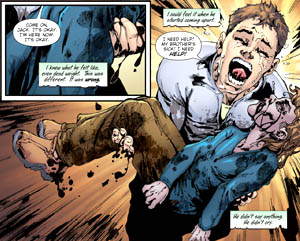 Written by Daniel Abraham
Written by Daniel Abraham
Art by Eric Battle
32 pages, color
Published by Dabel Brothers Productions
Writing a licensed comic book seems to be a peculiar sort of balancing act. It seems like there would be two obvious ways to approach the book; either assume that all your readers are familiar with the source material and just hit the ground running, or assume that none of your readers are familiar with the source material and spell everything out for them. Instead, a lot of these comics go for a strange sort of third option, trying to play to both crowds. In the case of Wild Cards: The Hard Call #1, all it seems to really create is a feeling of frustration.
In 1946, Earth was used as a massive petri dish for an alien virus, the Takisans testing their new biological weapon on humanity. The vast majority of those exposed to the "wild card virus" died instantly in horrific, terrifying mutations ("Black Queens"). Most of the survivors became "Jokers"—misshapen mutants that continued to live, unlike their unlucky compatriots. A rare few, though, not only kept their normal forms but gained super-powers, the lucky "Aces" in the deck. Now, in the present day, someone’s stolen a batch of an experimental cure for the virus in New York, while in Colorado someone has exposed an entire high school to a pocket of the wild card virus. And when your only hope to find the answer is the paranoid, increasingly-erratic Ace known as the Sleeper, well, things aren’t looking very good.
 I read the original Wild Cards books for years, although I must admit that I fell away from the series during the long publishing gap in the late ’90s. (Some of the more recent releases are sitting on my bookshelf, waiting patiently for me to finally read them.) When Wild Cards was still published regularly, though, I was always caught up with the series, able to recall all sorts of details and characters from over the years. I suspect that’s true for a lot of Wild Cards fans. So it’s with that in mind that I found Wild Cards: The Hard Call a little mystifying in places. Daniel Abraham can’t seem to figure out who he’s aiming the series towards and the end result is a bit of a mess. We get a huge dump of exposition about Roger Zelazny’s character Croyd Crenson (aka the Sleeper) that gives half of the information about the character (that Croyd regularly changes bodies and eats a lot when he wakes up) but bizarrely leaves out some of the most important part (the reason why he’s desperate to stay awake is that the change automatically happens when he falls asleep). So the end result is that people who already know who the character is get a little irritated that they have to sit through information they already know being spoon-fed to them, while brand-new readers are missing half of the information.
I read the original Wild Cards books for years, although I must admit that I fell away from the series during the long publishing gap in the late ’90s. (Some of the more recent releases are sitting on my bookshelf, waiting patiently for me to finally read them.) When Wild Cards was still published regularly, though, I was always caught up with the series, able to recall all sorts of details and characters from over the years. I suspect that’s true for a lot of Wild Cards fans. So it’s with that in mind that I found Wild Cards: The Hard Call a little mystifying in places. Daniel Abraham can’t seem to figure out who he’s aiming the series towards and the end result is a bit of a mess. We get a huge dump of exposition about Roger Zelazny’s character Croyd Crenson (aka the Sleeper) that gives half of the information about the character (that Croyd regularly changes bodies and eats a lot when he wakes up) but bizarrely leaves out some of the most important part (the reason why he’s desperate to stay awake is that the change automatically happens when he falls asleep). So the end result is that people who already know who the character is get a little irritated that they have to sit through information they already know being spoon-fed to them, while brand-new readers are missing half of the information.
Even stranger is an early scene at a science fair, where a young girl is explaining to people who pass by all about Wild Card Day and how the virus hit the planet—it’s once again a big exposition dump, which seems fair enough. The thing is, a major plot point in Wild Cards: The Hard Call is that a batch of the "trump virus" was stolen; at no point in the first issue, though, does anyone ever actually say what trump virus does. You’d think a line about "an experimental cure that restores a small percentage to normal" inserted into her information would have been easy to add in, but instead I had to actually head to a search engine to jog my memory of what this plot point was (which so far as I can remember, was last really featured in books back in the 1980s).
 As for the story itself, it’s all right. With only 22 actual pages of story, Abraham seems to split his focus a little too much for a first issue. Jumping from one location and character to the next works well in a novel, or short story with a high word limit, or even a graphic novel where you’ve got the entire story all together in one chunk. As a single issue, though, it makes you feel like you aren’t seeing that much actually happen. The basic idea of a batch of virus being used as an agent of death against a school is a solid one, and presumably the theft of the trump virus has something to do with the story as well. Hopefully the next issue will focus just on the pieces already in play and resist the urge to add in additional ones.
As for the story itself, it’s all right. With only 22 actual pages of story, Abraham seems to split his focus a little too much for a first issue. Jumping from one location and character to the next works well in a novel, or short story with a high word limit, or even a graphic novel where you’ve got the entire story all together in one chunk. As a single issue, though, it makes you feel like you aren’t seeing that much actually happen. The basic idea of a batch of virus being used as an agent of death against a school is a solid one, and presumably the theft of the trump virus has something to do with the story as well. Hopefully the next issue will focus just on the pieces already in play and resist the urge to add in additional ones.
Eric Battle’s art actually bothered me a little bit, and I think it’s because a Wild Cards comic needs someone with a cleaner art style. Battle is perfect when it comes to drawing the Jokers and Black Queens; the scene in the high school where the students are all drawing the Black Queen and mutating to their death is pitch-perfect, each person looking more twisted and horrific than the previous one. The problem is, Battle isn’t as adept with people that are supposed to look normal. When Alex is running with his brother, it’s actually a little hard to tell at a glance if Alex has mutated as well or not (he hasn’t) because his proportions aren’t quite right. Even worse, early on Croyd talks about how he’s got a good handsome body this time around, but the scene in the diner with him asking a redneck trucker (spouting exposition) shows Croyd’s new face to be distinctly unattractive and actually a little creepy because it just doesn’t seem normal (even though it’s supposed to be), a combination of puffy and greasy that is most not-attractive indeed. If this is supposed to be an attractive person, well, maybe that explains why Battle is so good at drawing those that aren’t supposed to be good looking.
I really wanted to like—make that love—a new Wild Cards comic mini-series. After the slightly disappointing attempt from Epic Comics so many years ago (where the only thing that really stood out was Butch Guice’s covers), and from a company known for their good tie-in comics, I was expecting fireworks. What we got, though, was more of a fizzle. Hopefully things will turn around in the issues to come, but right now this seems like a lot of halfway-theres with nothing actually succeeding.
